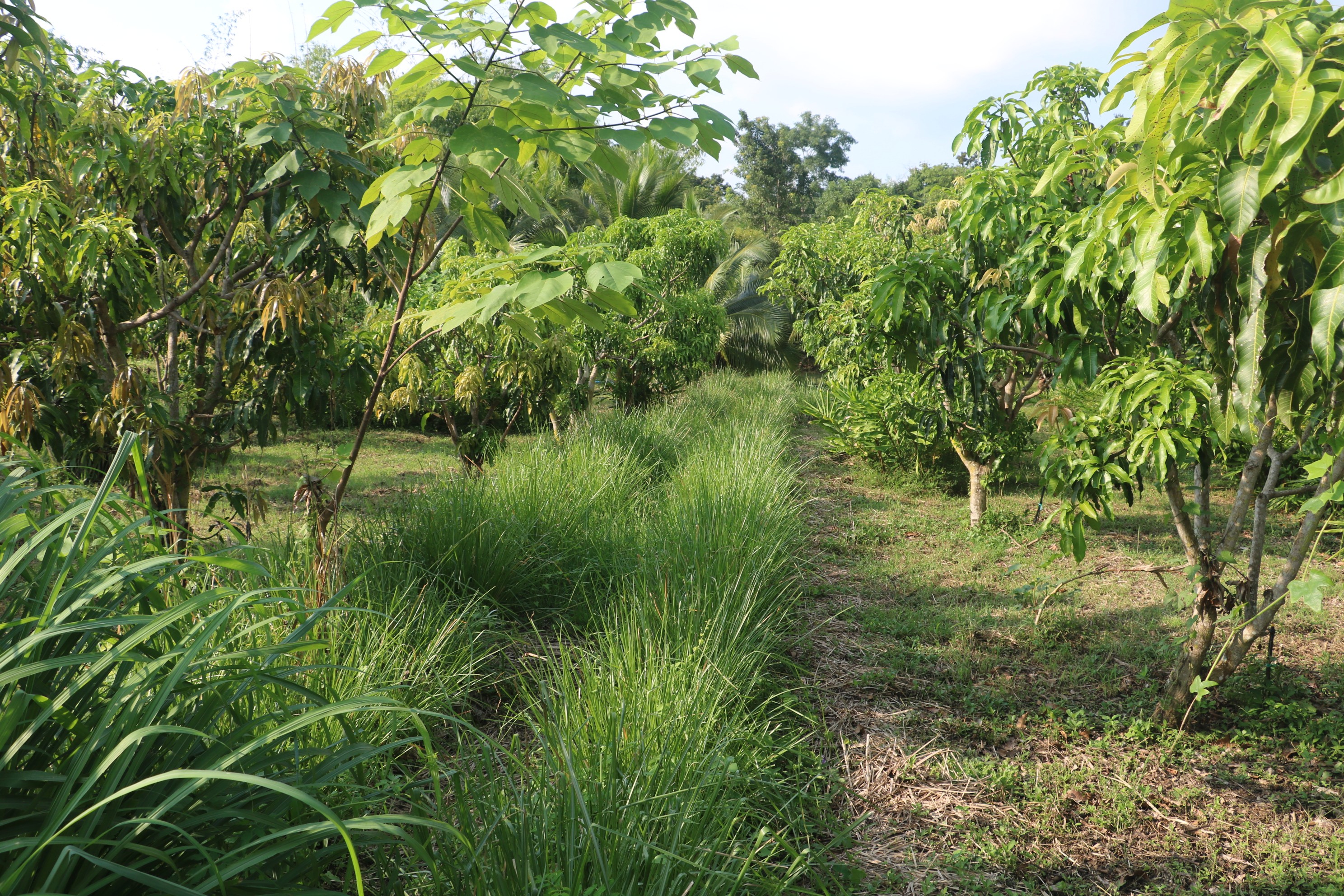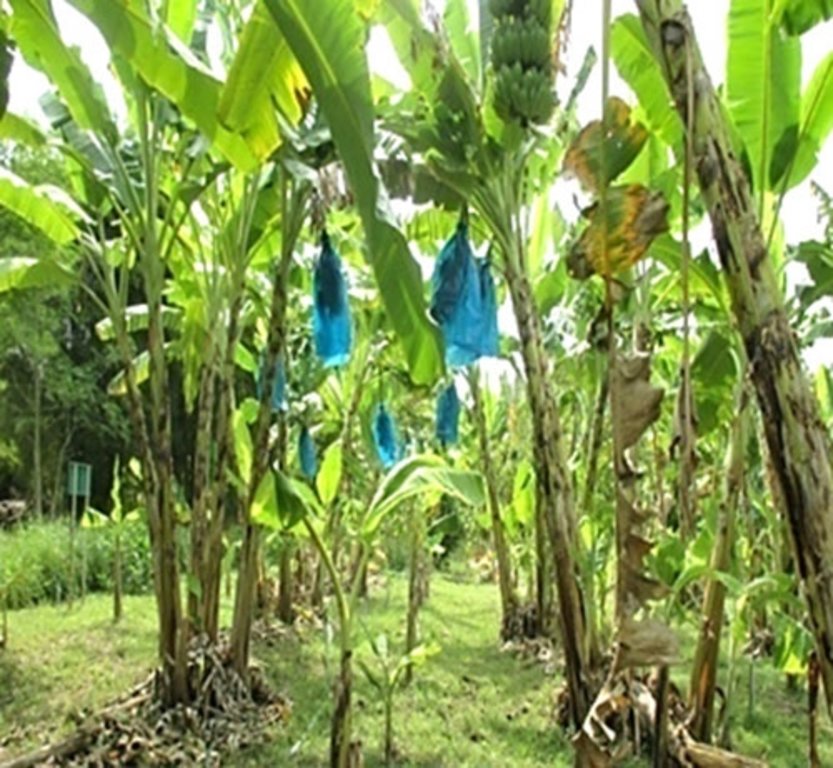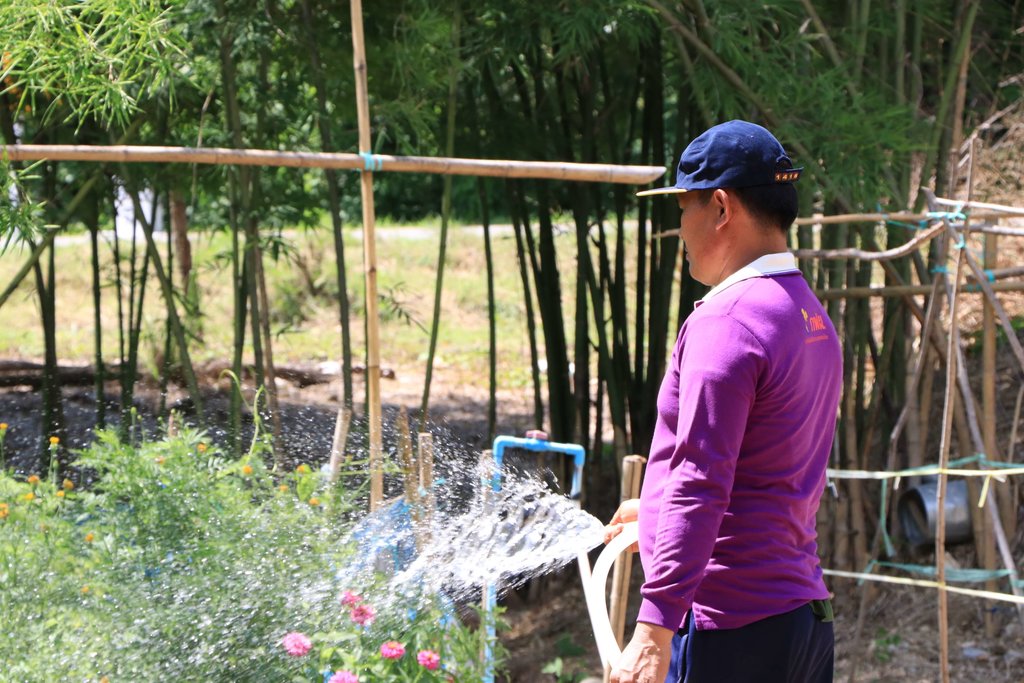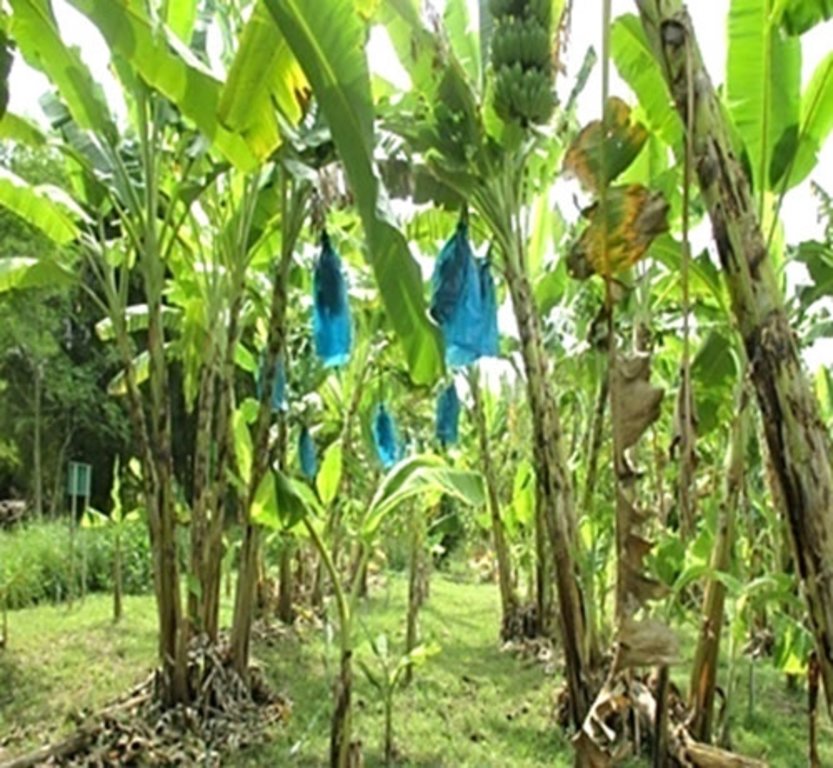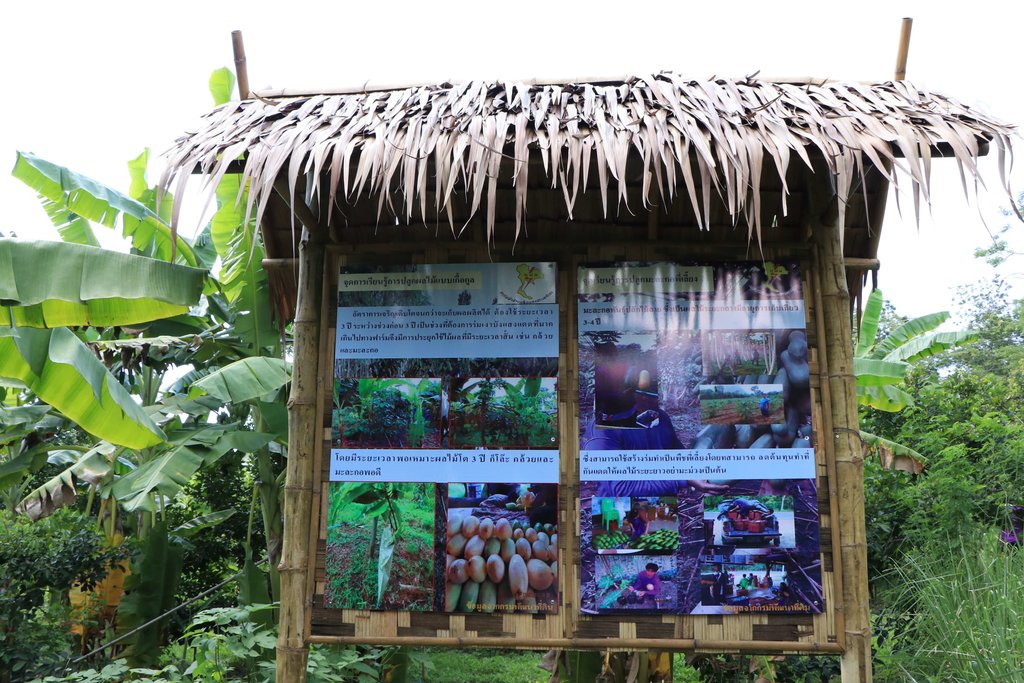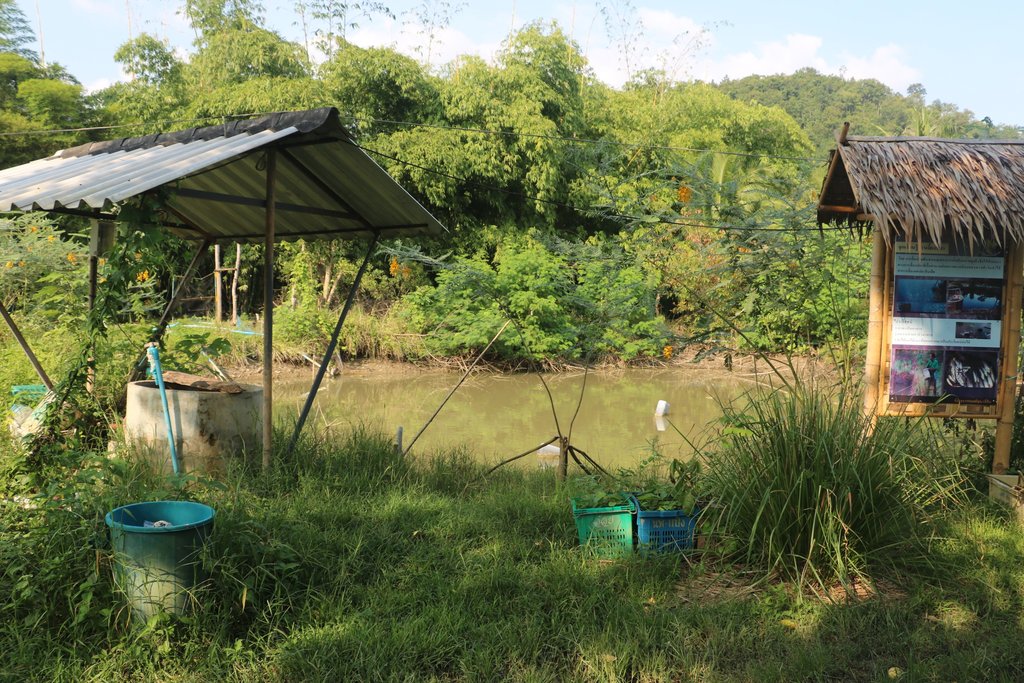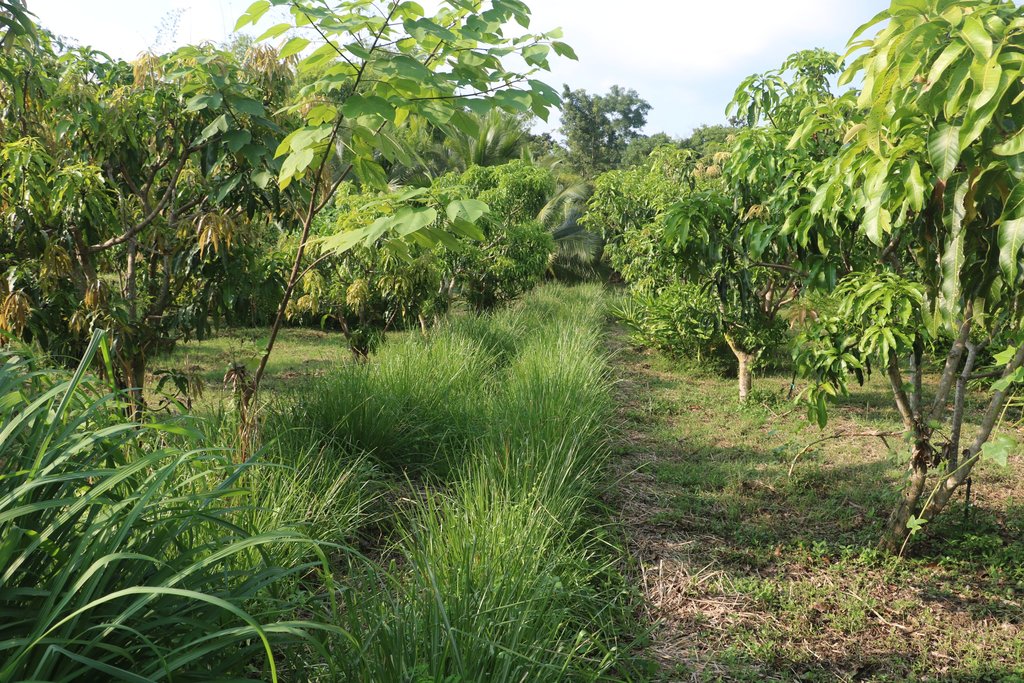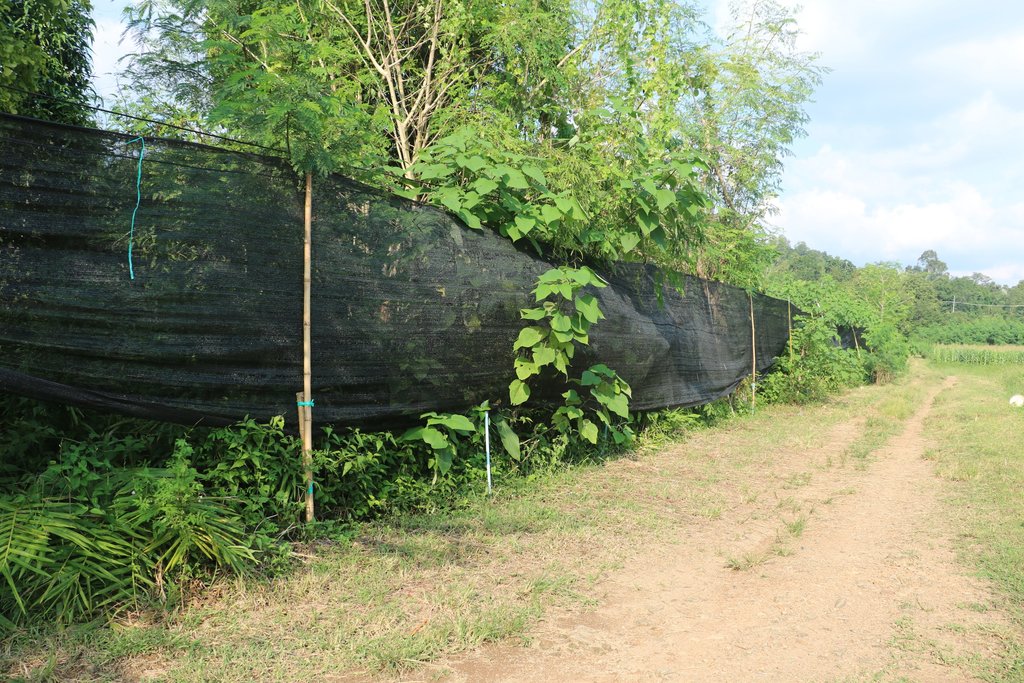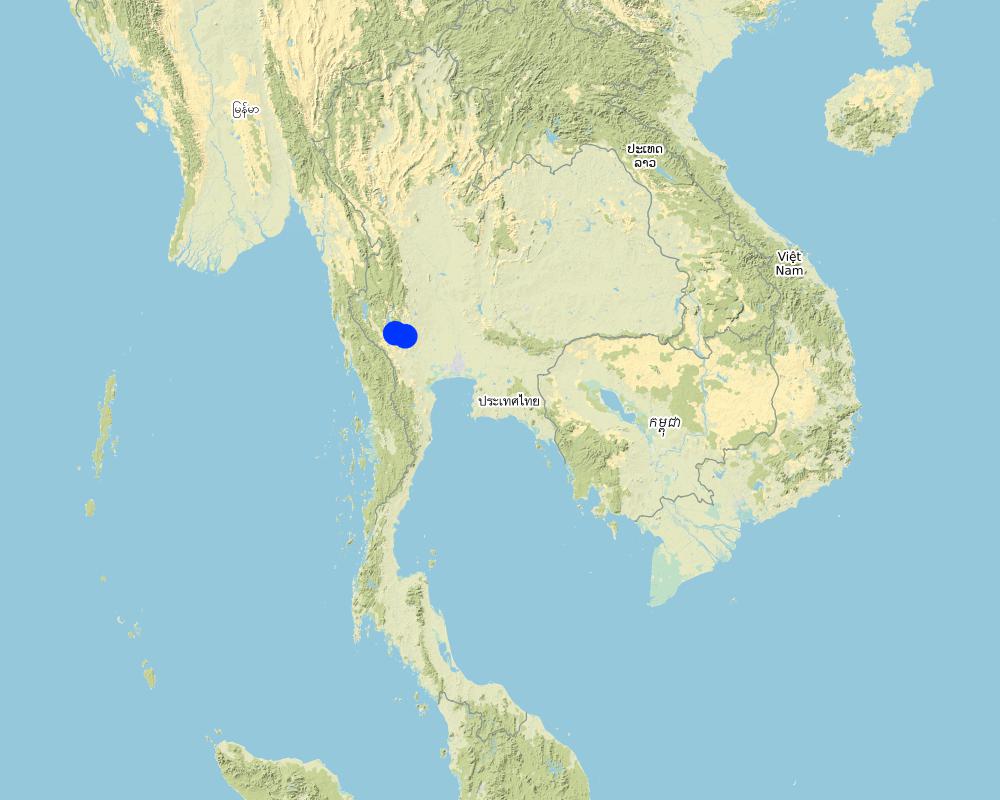Organic Farming on a Moderate Hillside Slope [Thailand]
- Creation:
- Update:
- Compiler: Kukiat SOITONG
- Editor: –
- Reviewers: Rima Mekdaschi Studer, William Critchley
เกษตรอินทรีย์บนพื้นที่ลาดเชิงเขา
technologies_4242 - Thailand
View sections
Expand all Collapse all1. General information
1.2 Contact details of resource persons and institutions involved in the assessment and documentation of the Technology
land user:
Mongkolkanjanakul Phatphong
-
Thailand
1.3 Conditions regarding the use of data documented through WOCAT
The compiler and key resource person(s) accept the conditions regarding the use of data documented through WOCAT:
Yes
1.4 Declaration on sustainability of the described Technology
Is the Technology described here problematic with regard to land degradation, so that it cannot be declared a sustainable land management technology?
No
Comments:
The farmer is able to apply the technology himself/ herself
1.5 Reference to Questionnaire(s) on SLM Approaches (documented using WOCAT)

Natural Agriculture Club [Thailand]
The Natural Agriculture Club is a group of farmers who conduct organic farming on sloping land. An organic farming technology transfer centre has been established.
- Compiler: Kukiat SOITONG
2. Description of the SLM Technology
2.1 Short description of the Technology
Definition of the Technology:
Organic farming on moderate hillside slopes protects the land, soil and water to produce sustainable and safe and natural farm products without the use of chemicals.
2.2 Detailed description of the Technology
Description:
Farming on sandy and gravelly sloping hillsides without soil and water conservation (SWC) measures causes erosion and thus reduces soil fertility. Any area grown to monocrops, such as maize, for a long time using high rates of chemical fertilizers and pesticides, will leave toxic residues in the products, becoming harmful to farmers’ and consumers’ health. Organic farming with the SWC measures is a solution. There are key elements to organic farming technology on sloping area. Soil fertility can be improved by growing leguminous green manures as well as applying compost. A farm should be divided by slope gradient for proper management in each zone. There should be ponds dug for water supply. An organic farm needs a buffer zone to help to control diseases and insects. Finally, weed control should be done by a mechanical method, leaving residues for mulching.
Organic farming in these areas restores soil fertility, balances the ecology and increases biodiversity, as well as reducing costs and generating more income. There are health benefits too. Procedures are as follows:
1. Increasing soil fertility: Grow green manure crops (jack bean and sunn hemp) alternately 6 times a year for 2 years. Incorporate the compost made from farm residues and the bio-fermented solution in the soil.
2. Zone management: The farming area should be divided by the slope zones for SWC measures and crop management. Grow vetiver grass on slopes to slow the flow of water, to trap sediment and to control insect pests. The farm should be divided into two parts. For moderately sloping hillsides area one should grow bamboo, fruit trees, and/or home-use forest, and for flatter areas one may grow bananas, papaya, vegetables, guava, herbs, fruits tree, etc.
3. On-farm water resources: Make an on-farm water resource by digging ponds and/or drilling groundwater for farming and home use. If a sprinkler system is installed; bio-fermented soil amendment solution is applied through the process of fertigation (nutrients in irrigation water).
4. The Buffer Zone is built by planting bamboo and trees to trap chemicals that might be blown through that space. The Buffer Zone width is 3-5 meters.
5. Pest control is carried out by using bio-fermented solution LDD 7.
6. Weed control is done by mechanical means, resulting in material to use for mulching and to increase organic matter.
7. Do farm accounting to know the cost of investment and of farm management.
To farmers there are some benefits from organic farming: soil becomes more fertile, cost of production is reduced, farm products are safe and meet the market’s demand, and the producers’ and consumers’ health is better. There is good cooperation among farmers, government and private agencies involved in the project. The use of the technology gives an opportunity to farmers to achieve the standard for certification. Organic farm products are under the government’s driven policy and there is good cooperation among public and private agencies which eventually increases farmers’ competitiveness.
2.3 Photos of the Technology
2.4 Videos of the Technology
Comments, short description:
-https://www.youtube.com/watch?time_continue=7&v=5INHx5_Hb6k
Location:
Moo 4 Ban Thungna, Nongpet Sub-district, Srisawat District, Kanchanaburi Province, Thailand (หมู่ 4 บ้านทุ่งนา ต. หนองเป็ด อ. ศรีสวัสดิ์ จ. กาญบุรี)
Name of videographer:
-
2.5 Country/ region/ locations where the Technology has been applied and which are covered by this assessment
Country:
Thailand
Region/ State/ Province:
Kanchanaburi
Further specification of location:
Moo4 Ban Thungna Tambon Nongpet Srisawat District Kanchanaburi province
Specify the spread of the Technology:
- applied at specific points/ concentrated on a small area
Comments:
-
Map
×2.6 Date of implementation
Indicate year of implementation:
2004
2.7 Introduction of the Technology
Specify how the Technology was introduced:
- through projects/ external interventions
Comments (type of project, etc.):
DOAE
3. Classification of the SLM Technology
3.1 Main purpose(s) of the Technology
- improve production
- reduce, prevent, restore land degradation
3.2 Current land use type(s) where the Technology is applied

Cropland
- Perennial (non-woody) cropping
- Tree and shrub cropping
- mango Papya Coconut guava bamboo

Grazing land
Comments:
-
3.3 Has land use changed due to the implementation of the Technology?
Comments:
-
3.4 Water supply
other (e.g. post-flooding):
- underground water well
Comments:
-
3.5 SLM group to which the Technology belongs
- windbreak/ shelterbelt
- integrated crop-livestock management
- integrated soil fertility management
3.6 SLM measures comprising the Technology

agronomic measures
- A2: Organic matter/ soil fertility

vegetative measures
- V1: Tree and shrub cover
Comments:
-
3.7 Main types of land degradation addressed by the Technology

soil erosion by water
- Wt: loss of topsoil/ surface erosion

chemical soil deterioration
- Cn: fertility decline and reduced organic matter content (not caused by erosion)

biological degradation
- Bq: quantity/ biomass decline
Comments:
-
3.8 Prevention, reduction, or restoration of land degradation
Specify the goal of the Technology with regard to land degradation:
- prevent land degradation
- reduce land degradation
4. Technical specifications, implementation activities, inputs, and costs
4.1 Technical drawing of the Technology
Technical specifications (related to technical drawing):
Procedures for the implementation of organic farming systems on sloping areas are as follow:
1. Increasing soil fertility (integrated use of mixed green manure with bio-fermented solution and compost): Grow green manure crops (jack bean and sunn hemp) alternately 6 times a year for 2 years. In practice, the sun hemp seed is sown at a rate of 5 kg/rai, let the plants grow and plow them over after 50-60 days. After that, spray bio-fermented solution (from fruit-vegetable mixture, treated with microorganisms) at a rate of 5 l bio-solution mixed with 100 l of water for an area of 1 rai. Let the decomposition go on for 12-15 days. Then grow jack bean at a rate 5-8 kg/rai in rows with row spacing of 75-100 cm and do the rest the same as for the sunn hemp. Finally, incorporate the compost made from farm residues and the bio-fermented solution in the soil.
2. The area management: The farming area should be divided by the slope grade for SWC measures and crop management. It is wise to grow the vetiver grass on a sloping area to slow down the flow of water, to trap sediment and to control insect pests. The farm area should be divided into two parts. For the moderate sloping hillside area one should grow bamboo, fruit tree, and/or home-use forest and for the plain area one may grow bananas, papaya, vegetables, guava, herbs, fruits tree, etc.
3. On-farm water resources: Making an on-farm water resource by digging ponds and/or drilling groundwater for farming and home use. The farming area is 34 rai, with a sprinkler system being installed; the bio-fermented solution is applied through the system.
4. The Buffer Zone is built by planting bamboo and home-use trees. In the area that such vegetations could not be planted, put the shading slant up to 2.5 m high, to trap the chemicals that might be blown through that space. The Buffer Zone width is 3-5 m.
5. Pest control is done by using bio-fermented solution LDD 7.
6. Weed control is done by a mechanical means, resulting in having material to use for mulching and to increase the organic matter.
7. Do farm accounting to know the cost of investment and of farm management.
Author:
Department of Agricultural Extension 2559
Date:
2016
4.2 General information regarding the calculation of inputs and costs
Specify how costs and inputs were calculated:
- per Technology area
Indicate size and area unit:
39 Rai
If using a local area unit, indicate conversion factor to one hectare (e.g. 1 ha = 2.47 acres): 1 ha =:
6.25rai
other/ national currency (specify):
(THB)
If relevant, indicate exchange rate from USD to local currency (e.g. 1 USD = 79.9 Brazilian Real): 1 USD =:
32.0
Indicate average wage cost of hired labour per day:
300 THB
4.3 Establishment activities
| Activity | Timing (season) | |
|---|---|---|
| 1. | amelioration | before planting |
| 2. | water system | dry season |
| 3. | weed control | growing period |
| 4. | Pest control | growing period |
| 5. | Buffer zone | rainy season |
| 6. | vetiver grass growing | rainy season |
| 7. | farm accounting | all year round |
4.4 Costs and inputs needed for establishment
| Specify input | Unit | Quantity | Costs per Unit | Total costs per input | % of costs borne by land users | |
|---|---|---|---|---|---|---|
| Labour | sunn hemp growing | time | 2.0 | 900.0 | 1800.0 | 100.0 |
| Labour | ploughing | time | 2.0 | 900.0 | 1800.0 | 100.0 |
| Labour | bio fermented solution spray | time | 2.0 | 900.0 | 1800.0 | 100.0 |
| Labour | applied compost | time | 1.0 | 1800.0 | 1800.0 | 100.0 |
| Equipment | applied Dolomite | time | 1.0 | 1600.0 | 1600.0 | 100.0 |
| Equipment | applied compost | time | 1.0 | 9000.0 | 9000.0 | 100.0 |
| Equipment | weed control | time | 8.0 | 9600.0 | 76800.0 | 100.0 |
| Equipment | pest control | time | 24.0 | 600.0 | 14400.0 | 100.0 |
| Equipment | shade net as buffer zone | pc | 2.0 | 600.0 | 1200.0 | 100.0 |
| Equipment | tree growing as buffer zone | time | 2.0 | 600.0 | 1200.0 | 100.0 |
| Equipment | maintenance/cutting vetiver grass leaf | time | 8.0 | 900.0 | 7200.0 | 100.0 |
| Equipment | accessories of underground water well | pc | 3.0 | 30000.0 | 90000.0 | 100.0 |
| Plant material | shade net | pc | 2.0 | 1700.0 | 3400.0 | 100.0 |
| Plant material | sunn hemp seed | kg | 63.0 | 33.0 | 2079.0 | 100.0 |
| Plant material | tree seedling for buffer zone | plant | 100.0 | 10.0 | 1000.0 | 100.0 |
| Plant material | vetiver grass seedling | plant | 150000.0 | 0.73 | 109500.0 | 100.0 |
| Fertilizers and biocides | land preparation | |||||
| Fertilizers and biocides | bio fermented solution | litre | 50.0 | 20.0 | 1000.0 | 100.0 |
| Fertilizers and biocides | Dolomite | kg | 4200.0 | 4.0 | 16800.0 | 100.0 |
| Fertilizers and biocides | compost | kg | 5500.0 | 4.0 | 22000.0 | 100.0 |
| Fertilizers and biocides | pesticide | litre | 50.0 | 30.0 | 1500.0 | 100.0 |
| Other | land preparation | |||||
| Other | land preparation | rai | 21.0 | 500.0 | 10500.0 | 100.0 |
| Other | under ground water well | well | 3.0 | 70000.0 | 210000.0 | 100.0 |
| Total costs for establishment of the Technology | 586379.0 | |||||
| Total costs for establishment of the Technology in USD | 18324.34 | |||||
If land user bore less than 100% of costs, indicate who covered the remaining costs:
-
Comments:
-
4.5 Maintenance/ recurrent activities
| Activity | Timing/ frequency | |
|---|---|---|
| 1. | irrigation system | 2 times a year before and after rainy season |
| 2. | weed control | 12 times a year during cropping season |
| 3. | pest control | 12 times a year during cropping season |
| 4. | buffer zone | 2 times a year before and after cropping season |
| 5. | vetiver grass | 12 times a year during cropping season |
Comments:
-
4.6 Costs and inputs needed for maintenance/ recurrent activities (per year)
| Specify input | Unit | Quantity | Costs per Unit | Total costs per input | % of costs borne by land users | |
|---|---|---|---|---|---|---|
| Labour | weed control | time | 8.0 | 1200.0 | 9600.0 | 100.0 |
| Labour | pest control | time | 24.0 | 600.0 | 14400.0 | 100.0 |
| Labour | buffer zone maintenance | time | 6.0 | 300.0 | 1800.0 | 100.0 |
| Labour | cutting vetiver grass row | time | 8.0 | 900.0 | 7200.0 | 100.0 |
| Other | electricity for irrigation | month | 12.0 | 500.0 | 6000.0 | 100.0 |
| Total costs for maintenance of the Technology | 39000.0 | |||||
| Total costs for maintenance of the Technology in USD | 1218.75 | |||||
If land user bore less than 100% of costs, indicate who covered the remaining costs:
-
Comments:
-
4.7 Most important factors affecting the costs
Describe the most determinate factors affecting the costs:
Utility bills, electricity, drilling an artesian well and system, labour and transportation cost
5. Natural and human environment
5.1 Climate
Annual rainfall
- < 250 mm
- 251-500 mm
- 501-750 mm
- 751-1,000 mm
- 1,001-1,500 mm
- 1,501-2,000 mm
- 2,001-3,000 mm
- 3,001-4,000 mm
- > 4,000 mm
Specify average annual rainfall (if known), in mm:
1600.00
Specifications/ comments on rainfall:
This is a rain shadow area, a few rain events, very hot during summer and very cold in winter, max temp 44-45 degree celsius in April, minimum temp in December 8-9 degree Celsius, average temp 27 degree celsius rainy season starting April until mid-October.
Indicate the name of the reference meteorological station considered:
-
Agro-climatic zone
- humid
-
5.2 Topography
Slopes on average:
- flat (0-2%)
- gentle (3-5%)
- moderate (6-10%)
- rolling (11-15%)
- hilly (16-30%)
- steep (31-60%)
- very steep (>60%)
Landforms:
- plateau/plains
- ridges
- mountain slopes
- hill slopes
- footslopes
- valley floors
Altitudinal zone:
- 0-100 m a.s.l.
- 101-500 m a.s.l.
- 501-1,000 m a.s.l.
- 1,001-1,500 m a.s.l.
- 1,501-2,000 m a.s.l.
- 2,001-2,500 m a.s.l.
- 2,501-3,000 m a.s.l.
- 3,001-4,000 m a.s.l.
- > 4,000 m a.s.l.
Indicate if the Technology is specifically applied in:
- concave situations
Comments and further specifications on topography:
The majority of land is plateau plain close to SriNaklarin Dam Topography is lime stone mountain and sediment stone Highest point 1,100 meters above sea level, average high is 400 meters
5.3 Soils
Soil depth on average:
- very shallow (0-20 cm)
- shallow (21-50 cm)
- moderately deep (51-80 cm)
- deep (81-120 cm)
- very deep (> 120 cm)
Soil texture (topsoil):
- medium (loamy, silty)
Soil texture (> 20 cm below surface):
- fine/ heavy (clay)
Topsoil organic matter:
- medium (1-3%)
5.4 Water availability and quality
Ground water table:
> 50 m
Availability of surface water:
good
Water quality (untreated):
for agricultural use only (irrigation)
Is water salinity a problem?
No
Is flooding of the area occurring?
No
Comments and further specifications on water quality and quantity:
-
5.5 Biodiversity
Species diversity:
- medium
Habitat diversity:
- medium
Comments and further specifications on biodiversity:
-
5.6 Characteristics of land users applying the Technology
Sedentary or nomadic:
- Sedentary
Market orientation of production system:
- mixed (subsistence/ commercial)
Off-farm income:
- less than 10% of all income
Relative level of wealth:
- average
Individuals or groups:
- individual/ household
Level of mechanization:
- manual work
Gender:
- men
Age of land users:
- middle-aged
Indicate other relevant characteristics of the land users:
-
5.7 Average area of land used by land users applying the Technology
- < 0.5 ha
- 0.5-1 ha
- 1-2 ha
- 2-5 ha
- 5-15 ha
- 15-50 ha
- 50-100 ha
- 100-500 ha
- 500-1,000 ha
- 1,000-10,000 ha
- > 10,000 ha
Is this considered small-, medium- or large-scale (referring to local context)?
- large-scale
Comments:
-
5.8 Land ownership, land use rights, and water use rights
Land ownership:
- individual, titled
Land use rights:
- individual
Water use rights:
- individual
Specify:
-
Comments:
-
5.9 Access to services and infrastructure
health:
- poor
- moderate
- good
education:
- poor
- moderate
- good
technical assistance:
- poor
- moderate
- good
employment (e.g. off-farm):
- poor
- moderate
- good
markets:
- poor
- moderate
- good
energy:
- poor
- moderate
- good
roads and transport:
- poor
- moderate
- good
drinking water and sanitation:
- poor
- moderate
- good
financial services:
- poor
- moderate
- good
Comments:
-
6. Impacts and concluding statements
6.1 On-site impacts the Technology has shown
Socio-economic impacts
Production
crop production
Comments/ specify:
-
crop quality
Comments/ specify:
-
animal production
Comments/ specify:
-
product diversity
Comments/ specify:
-
land management
Comments/ specify:
-
Water availability and quality
drinking water quality
Comments/ specify:
-
Income and costs
expenses on agricultural inputs
Comments/ specify:
-
farm income
Comments/ specify:
-
diversity of income sources
workload
Comments/ specify:
-
Socio-cultural impacts
food security/ self-sufficiency
Comments/ specify:
-
health situation
Comments/ specify:
-
community institutions
Comments/ specify:
-
SLM/ land degradation knowledge
Comments/ specify:
-
Ecological impacts
Soil
soil moisture
Comments/ specify:
-
soil loss
Comments/ specify:
-
nutrient cycling/ recharge
Comments/ specify:
-
soil organic matter/ below ground C
Comments/ specify:
-
Biodiversity: vegetation, animals
plant diversity
Comments/ specify:
-
Climate and disaster risk reduction
drought impacts
Comments/ specify:
-
emission of carbon and greenhouse gases
Comments/ specify:
-
fire risk
Comments/ specify:
-
wind velocity
Comments/ specify:
-
Specify assessment of on-site impacts (measurements):
-
6.2 Off-site impacts the Technology has shown
downstream siltation
Comments/ specify:
-
groundwater/ river pollution
Comments/ specify:
-
damage on neighbours' fields
Comments/ specify:
-
Specify assessment of off-site impacts (measurements):
-
6.3 Exposure and sensitivity of the Technology to gradual climate change and climate-related extremes/ disasters (as perceived by land users)
Gradual climate change
Gradual climate change
| Season | increase or decrease | How does the Technology cope with it? | |
|---|---|---|---|
| annual temperature | decrease | moderately | |
| seasonal temperature | decrease | moderately | |
| annual rainfall | moderately | ||
| seasonal rainfall | moderately |
Climate-related extremes (disasters)
Meteorological disasters
| How does the Technology cope with it? | |
|---|---|
| local rainstorm | moderately |
Climatological disasters
| How does the Technology cope with it? | |
|---|---|
| drought | well |
| forest fire | moderately |
Biological disasters
| How does the Technology cope with it? | |
|---|---|
| epidemic diseases | not well |
Other climate-related consequences
Other climate-related consequences
| How does the Technology cope with it? | |
|---|---|
| extended growing period | not well |
| reduced growing period | well |
Comments:
-
6.4 Cost-benefit analysis
How do the benefits compare with the establishment costs (from land users’ perspective)?
Short-term returns:
slightly negative
Long-term returns:
positive
How do the benefits compare with the maintenance/ recurrent costs (from land users' perspective)?
Short-term returns:
neutral/ balanced
Long-term returns:
positive
Comments:
-
6.5 Adoption of the Technology
- 1-10%
If available, quantify (no. of households and/ or area covered):
10 ครัวเรือน
Of all those who have adopted the Technology, how many did so spontaneously, i.e. without receiving any material incentives/ payments?
- 0-10%
Comments:
-
6.6 Adaptation
Has the Technology been modified recently to adapt to changing conditions?
Yes
other (specify):
adjust the expenditure ,must more saving approach and keeping more details
Specify adaptation of the Technology (design, material/ species, etc.):
Reduce the use of energy by using solar cell for water pump.
6.7 Strengths/ advantages/ opportunities of the Technology
| Strengths/ advantages/ opportunities in the land user’s view |
|---|
| More fertility in the agricultural production area |
| Cost reduction |
| Safe food production |
| Higher price of products |
| Farmers/consumers have better health |
| Good transportation and easy access to the market |
| More opportunity to learn and to get more knowledge |
| Better cooperation among supporting agencies from both public and private sectors |
| The standard of product certification gives confidence to markets and create good demand for the products from them. |
| Strengths/ advantages/ opportunities in the compiler’s or other key resource person’s view |
|---|
| The public policy supports the organic agriculture. |
| Cooperation among farmers and the public sectors makes more chance and competitiveness of production. |
6.8 Weaknesses/ disadvantages/ risks of the Technology and ways of overcoming them
| Weaknesses/ disadvantages/ risks in the land user’s view | How can they be overcome? |
|---|---|
| Organic agriculture takes longer time than normal | find out the technology to be the solution |
| Need more Buffer Zone to protect the effect from outside fields | need any regulation to support and protect the organic production area/zone |
| Organic product certification takes time and many steps related agencies | ) related agencies should try to reduce the time and improve the process of certification |
| More labour and time to provide raw material in making organic fertilizers | explore other alternatives, e.g. local materials and sources, to reduce the cost of production |
| Misunderstanding/confused on organic products by consumers | to do more public relations and/or campaign |
| High cost of production and no difference in the prices of organic and general products | related organizations should do more public relations to increase the understanding of the public |
| Weaknesses/ disadvantages/ risks in the compiler’s or other key resource person’s view | How can they be overcome? |
|---|---|
| Lack of systematic land use planning farmer | give more information and knowledge |
| Misunderstanding /lack of knowledge on soil improvement of organic farmers | more training |
| Lack of organic supply chain and marketing of organic farmers | more information and make it easy to access |
| Pricing and price volatility of organic products are a major problem of organic farming | public and related agencies should help in supervising/or making a control system |
7. References and links
7.1 Methods/ sources of information
7.2 References to available publications
Title, author, year, ISBN:
-
Available from where? Costs?
-
7.3 Links to relevant online information
Title/ description:
-
7.4 General comments
-
Links and modules
Expand all Collapse allLinks

Natural Agriculture Club [Thailand]
The Natural Agriculture Club is a group of farmers who conduct organic farming on sloping land. An organic farming technology transfer centre has been established.
- Compiler: Kukiat SOITONG
Modules
No modules


